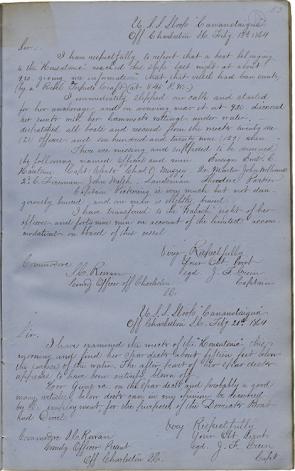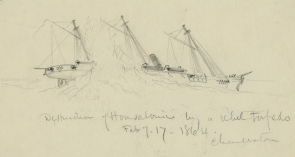The H. L. Hunley Sinks the USS Housatonic
Posted by justine.ahlstrom on Tuesday, 06/13/2017
 On the night of February 17, 1864, during the Civil War, the Confederacy made naval history off Charleston, South Carolina. The H. L. Hunley became the first submarine to sink an enemy ship, the USS Housatonic, in combat. Captain Joseph Foster Green of the USS Canandaigua took on the Housatonic’s survivors. Captain Green’s official letterbooks are a part of the Gilder Lehrman Collection. Through them, we see the Union navy’s response to this game-changing innovation. On February 18, Green wrote to Commodore Stephen C. Rowan to report the sinking:
On the night of February 17, 1864, during the Civil War, the Confederacy made naval history off Charleston, South Carolina. The H. L. Hunley became the first submarine to sink an enemy ship, the USS Housatonic, in combat. Captain Joseph Foster Green of the USS Canandaigua took on the Housatonic’s survivors. Captain Green’s official letterbooks are a part of the Gilder Lehrman Collection. Through them, we see the Union navy’s response to this game-changing innovation. On February 18, Green wrote to Commodore Stephen C. Rowan to report the sinking:
I have respectfully to report that a boat belonging to the "Housatonic" reached this ship last night at about 9.20. giving me information that that vessel had been sunk, (by a Rebel Torpedo Craft) (at 8.45' P.M.)
I immediately slipped our cable and started for her anchorage, and on arriving near it at 9.30 discovered her sunk with her hammock nettings under water; ¾ dispatched all boats and rescued from the wreck twenty one (21) officers and one hundred and twenty nine (129) men.
There are missing and supposed to be drowned the following named Officers and men. Ensign Ewd C. Haseltine, Capts Clerk Chas. O. Muzzey, Qr Master John Williamss, 2nd C. Fireman John Walsh, Landsman Theodore Parker.
 Subsequent letters contain information about the crew and inquiries made into the sinking. But perhaps the most telling letter was written on May 23, 1864. In it, Green describes the uneasy state of the Union fleet, awaiting another attack from a "Rebel Torpedo Craft." He reports that on May 20 something was spotted in the water near the Housatonic wreck:
Subsequent letters contain information about the crew and inquiries made into the sinking. But perhaps the most telling letter was written on May 23, 1864. In it, Green describes the uneasy state of the Union fleet, awaiting another attack from a "Rebel Torpedo Craft." He reports that on May 20 something was spotted in the water near the Housatonic wreck:
The fact of a strange object being seen on the surface of the water two consecutive nights in the neighborhood and track of the blockading vessels, and disappearing suddenly, is sufficient cause for suspecting the strange object to have been a "Rebel Torpedoe Craft": – and it is best in my opinion that this suspicion should exist so long as it does not amount to a panic, in order to arouse the greatest vigilance on the part of officers and Men.
I am doubtful, however, as to it having been a Torpedoe Craft, particularly after my experience this morning at daylight while standing in for an anchorage. . . . when an object resembling a Keg was discovered a little abaft our starboard beam. I immediately wore around stood for and endeavored to keep sight of, but lost it. Soon after, an object in the water, differing in appearance from that first seen, was discovered in another direction, which on approaching proved to be an old straw hat. I then stood in again for an anchorage, and had gone but a little distance when the first object seen was again discovered. I stood for and succeeded in picking it up, it proved to be a common chair, it floated on its back with the seat about two thirds out of water, consequently, when the seat was at right angles with the line of sight, it appeared like a Keg, and when parallel to the line of sight, or edge on, it could not be seen.
The Union navy did not know that the Hunley sank on the same night as the Housatonic and that the Confederates did not have another submarine.
In 1995, the National Underwater and Marine Agency located the wreck of the Hunley in Charleston harbor. On August 8, 2000, the US Navy, the Hunley Commission, and Friends of the Hunley raised the sub and sent it to Warren Lasch Conservation Center at Clemson University. For the last seventeen years, conservators have worked to free the ship from the sediment that encased it. The crew compartment was opened and the eight-man crew received a formal burial in 2004. The work continues today. Learn more about the project from the Naval History and Heritage Command.
You can read more about the development of another Confederate submarine, the David, here.